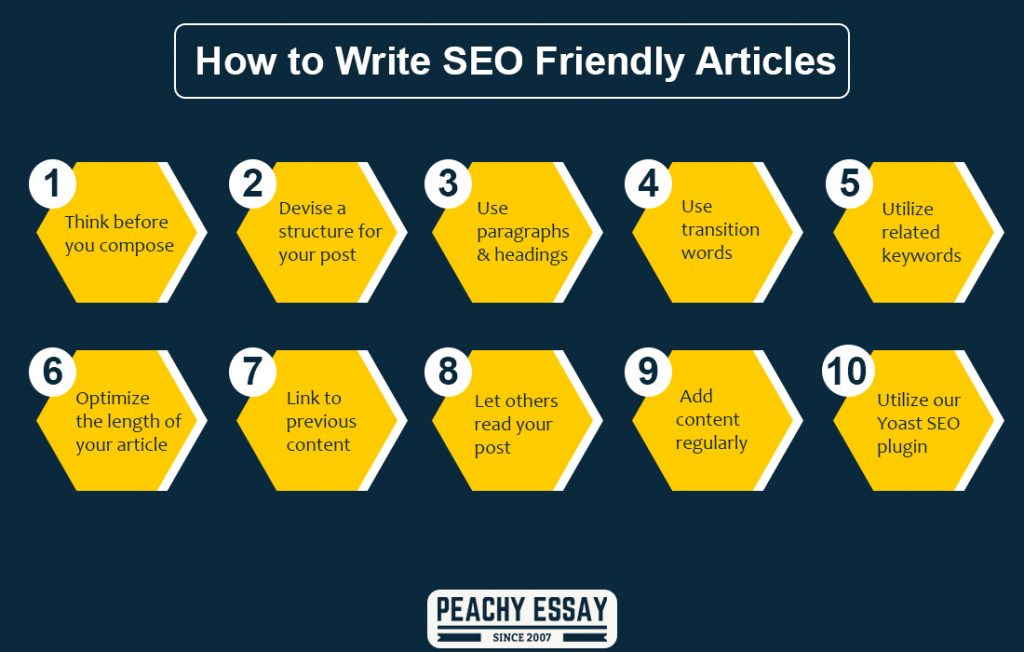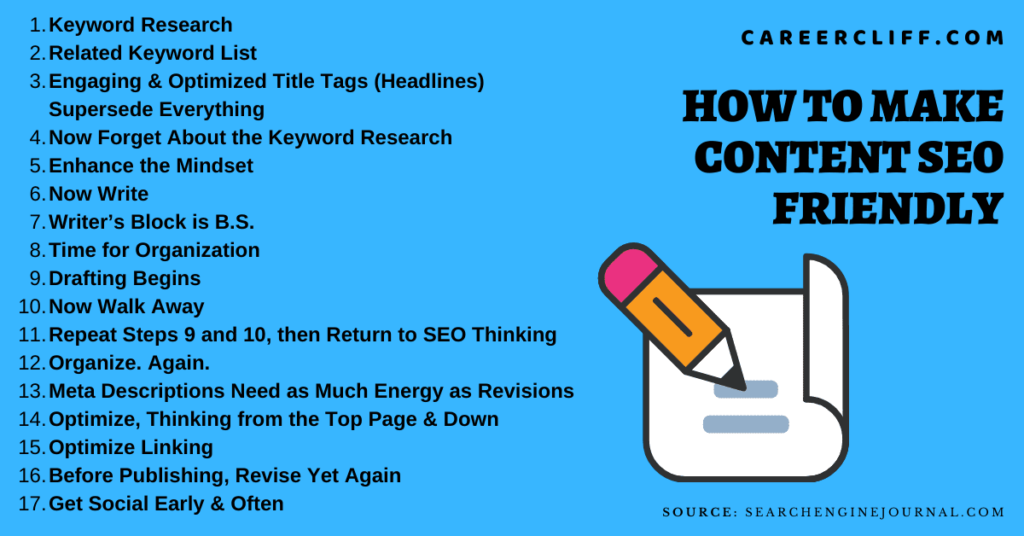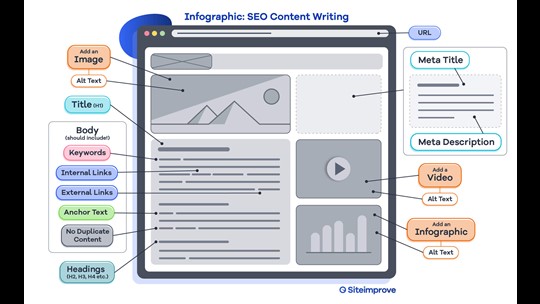Want to learn the secrets to writing SEO-friendly articles that will drive traffic to your website? Follow this step-by-step guide.

Image courtesy of via DALL-E 3
Table of Contents
Welcome to the world of writing an SEO-friendly article! Today, we’re going to explore some exciting tips and tricks to help your online content stand out and get noticed. But first, let’s understand what exactly an SEO-friendly article is and why it’s important for your blog or website.
When we talk about an SEO-friendly article, we’re referring to a piece of writing that is crafted in a way that search engines like Google can easily find it. By incorporating specific keywords and following certain guidelines, you can increase the chances of your article showing up higher in search results, making it easier for people to discover and read your content.
So, if you’re ready to learn how to write articles that not only captivate your audience but also get noticed by search engines, then let’s dive into some valuable blogging tips that will take your online content to the next level!
What is SEO?
SEO stands for Search Engine Optimization. It’s like a secret code that helps your articles get noticed on the internet. When you use SEO, it’s easier for people to find what you write!
Simple Definition
SEO is like using special words that make your articles show up when someone searches for something online. It’s like putting up a big sign that says, “Hey, check out this cool article!”
Why SEO Matters
Using SEO is important because it helps your articles stand out in a sea of other content. Imagine you have a lemonade stand, but it’s on a street with many other stands. Using SEO is like having a giant lemonade sign that draws people to your stand instead of the others!
Choosing the Right Keywords
In order to write an SEO-friendly article that people can easily find online, it’s important to choose the right keywords for your content. Keywords are the words and phrases that people type into search engines like Google when they’re looking for information on a specific topic. By including the right keywords in your article, you can increase the chances of it being seen by more readers. Here’s a simple guide on how to pick the best words that people might use to search for your topic.
What Are Keywords?
Keywords are like the secret code that helps search engines understand what your article is about. When someone searches for a topic that matches your keywords, search engines like Google will show your article in the search results. Think of keywords as the key to unlocking your article and making it visible to those who are looking for information on that subject.
How to Find Keywords
Now that you know what keywords are, the next step is to find the right ones for your article. But how can you do that? Don’t worry, there are kid-friendly tools and methods available to help you with this task. Some simple ways to find popular keywords include using tools like Google Keyword Planner, looking at what words appear frequently in articles about your topic, or asking friends and family what words they would use to search for your topic.
Creating a Catchy Title
Titles are like the first impression of your article. They are the words that grab the reader’s attention and make them want to know more. When you have a good title, more people will click on your article and read it. That’s why it’s super important to spend some time coming up with a catchy title!

Image courtesy of peachyessay.com via Google Images
Tips for Writing Titles
Here are some simple tips to help you write a title that stands out:
1. Use your main keyword in the title to let readers know what your article is about.
2. Keep it short and sweet. A long title might make people lose interest.
3. Make it interesting and exciting. Use words that make people curious.
4. Think about what would make you want to click on an article. Use that to create your title!
Writing an Engaging Introduction
When you start writing your article, the introduction is like the handshake you give to your readers. It’s the first thing they see, so you want to make sure it’s engaging and interesting. In this section, I’ll show you how to craft an introduction that grabs your readers’ attention while also including those important SEO-friendly keywords.
Starting with a Hook
A hook is like a magical spell that captures your readers’ attention and makes them want to keep reading. It can be a surprising fact, a funny joke, or a thought-provoking question. Imagine you’re telling a story to your friends to get them excited about what’s coming next. That’s what a hook does in your introduction!
Introducing the Topic
After you’ve hooked your readers, it’s time to gently introduce the topic of your article. Think of it as setting the stage for the main show. Here’s where you can briefly explain what your article is about and why it’s interesting. Remember to sprinkle in those important keywords naturally so that search engines can easily find your article.
Building the Main Content
Now that you have your catchy title and engaging introduction, it’s time to dive into building the main content of your article. This is where you get to share all the important information you want your readers to know.

Image courtesy of www.peppercontent.io via Google Images
Organizing Information
Before you start writing, take a moment to plan out how you want to organize your article. Think about the main points you want to cover and how you can structure them in a logical way. It’s like creating a roadmap for your readers to follow as they go through your article.
Using Keywords Naturally
As you write your main content, remember to sprinkle your chosen keywords throughout the text. But make sure to do it in a natural way that doesn’t make the article sound forced or repetitive. Think about how people would search for your topic and incorporate those keywords smoothly into your writing.
Keeping It Simple
When writing the main content of your article, it’s important to keep things simple and easy to understand. Avoid using complicated language or overloading your readers with too much information. Stick to the main points and explain them clearly so that even someone new to the topic can follow along.
Adding Images and Media
Images and videos can make your article more exciting and help readers better understand your content. When choosing images, make sure they are related to what you are writing about. For example, if you’re writing an article about dogs, include pictures of different dog breeds or a cute puppy playing in the park. This not only makes your article visually appealing but also helps to keep your readers engaged.
Using Alt Text
Alt text is a short description that you can add to an image to tell search engines what the image is about. This is important for SEO because search engines can’t “see” images like humans can, so they rely on alt text to understand what the image is depicting. When adding alt text, be sure to describe the image accurately and include your main keyword if possible. This helps search engines index your images correctly and can improve your article’s search engine ranking.
Concluding Your Article
As you reach the end of your article, it’s important to wrap things up in a way that leaves a lasting impression on your readers. This is your chance to reinforce the main points you’ve discussed and encourage further engagement with your content. Let’s dive into some tips on how to effectively conclude your article.

Image courtesy of www.siteimprove.com via Google Images
Summarizing Key Points
One way to wrap up your article is by summarizing the key points you’ve covered. Think of this as a quick recap for your readers, reminding them of the most important information they should take away from your piece. By reiterating these main ideas, you help reinforce the message you want to convey and make it easier for your audience to remember what they’ve learned.
Encouraging Reader Interaction
Another crucial aspect of concluding your article is to encourage reader interaction. You can do this by inviting your audience to leave comments, share your post on social media, or ask questions related to the topic. Engaging with your readers in this way not only fosters a sense of community around your content but also signals to search engines that your article is valuable and deserving of attention.
By summarizing key points and encouraging reader interaction, you can effectively conclude your article and leave a lasting impact on your audience. Remember, the conclusion is your final chance to leave a positive impression, so make it count!
Want to turn these SEO insights into real results? Seorocket is an all-in-one AI SEO solution that uses the power of AI to analyze your competition and craft high-ranking content.
Seorocket offers a suite of powerful tools, including a Keyword Researcher to find the most profitable keywords, an AI Writer to generate unique and Google-friendly content, and an Automatic Publisher to schedule and publish your content directly to your website. Plus, you’ll get real-time performance tracking so you can see exactly what’s working and make adjustments as needed.
Stop just reading about SEO – take action with Seorocket and skyrocket your search rankings today. Sign up for a free trial and see the difference Seorocket can make for your website!
Frequently Asked Questions (FAQs)
What If I Can’t Find Keywords?
If you’re having trouble finding keywords for your article, don’t worry! You can try thinking about what words someone might use to search for your topic. You can also use online tools that suggest popular keywords related to your subject. Remember, keywords are just words that people often type into search engines when looking for information.
How Many Keywords Should I Use?
It’s important to use keywords in your article, but you don’t want to overdo it. Try to include your main keyword a few times throughout your writing, but make sure it flows naturally. Using too many keywords can make your article sound strange and spammy, so aim for a balance that feels comfortable and makes sense.
Can I Use the Same Keywords in Every Article?
While it’s okay to use the same keywords across different articles if they fit well with the content, it’s actually beneficial to use a variety of keywords. Using different keywords in each article can help you reach a wider audience and attract more readers who are searching for different things. So, feel free to mix it up and experiment with different keyword combinations to see what works best for each piece of content you create.







